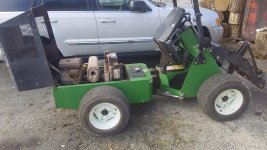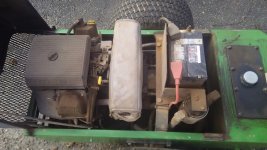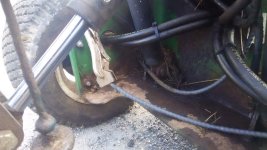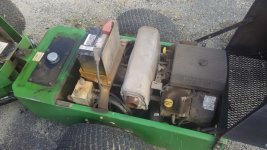So I finally have had the time off of work to take inventory of my new (used) PT-425 with the Kohler 25 engine. I'm pretty pleased with her, and have slowly started going through her unencumbered by any kind of manual or direction, so I have a few questions. I can tell that the machine and attachments have sat outside for a long time, with little if any use, so I greased all of the zerks I could find (2 on the lift arm and 2 at the pivot point) and have done some cleaning. She's got 650 hours showing on the ticker. The parking brake cables are broken and disconnected as you can see in the pic, but I'll get to that later. I am getting ready to do 50 hour maintenance, which I believe involves changing the oil and the hydraulic filter. Here are my questions that I cannot seem to find answers to:
1) What oil / filter on the Kohler do I use? How much oil does it take?
2) How do I check the hydraulic oil level? The tank seems to be about 1/3 full, with the fluid just touching the dipstick. Is that right?
3) Do I need to change all of the hydro fluid or just screw on a new filter? Do I need to bleed any air? I don't have any experience with hydraulics yet.
Any maintenance you could suggest before I put this thing to hard work would be much appreciated. I'm excited to finally have joined the PT owners ranks and I hope my first set of pics upload.
Regards,
Dan
Find a good, local, lawn and garden or small engine shop in your town and ask for a Kohler command pro CH25s (if that is indeed your engine model) oil filter. I think there's a long and short version, so measure your's first. Start the engine to get the oil warm. Only takes a minute or two. Shut off the engine. Locate the engine oil drain plug under the engine. A socket on and extension through the bottom of the tub should work. Mine has a 90 degree elbow so it drains out the side of the engine, then strait down through a hole in the tub. Put a wide, shallow pan under the engine. Remove the drain plug and drain into the pan. Let it drain for 10 minutes or so. You'll know is empty when its empty. Replace the drain cap. Remove the oil filter. Put some paper towels down first. It will spill. Oil the gasket on the new filter. Since the filter is at a horizontal orientation, you can't fill it before installing. Install the oil filter. Now its time to fill the engine with oil. The amount is in the PDF manual that I linked to in the previous post. I think its two quarts-ish, so buy three quarts of Mobile 1 5w30 or whatever weight the manual calls for. Add a quart and check the stick. If nothing shows, add 1/4 quart at a time and keep checking the stick until it gets to the full line. Start the engine for 30 seconds and shut it off. Wait a minute and check the level again. It should have gone down a bit due to the filter filling, but not much. Top off and check again every time before you operate the machine. Change the engine oil and filter every 50 hours of operation, or once per year, whichever comes first.
To check the hydraulic oil, just clean the cap and area around it first, then remove the cap and read the stick. I keep mine about an inch up from the bottom of the stick. It should be relatively clear. I've never changed mine in 14 years with about 600 hours. I do add a quart every 50 hours when I change my hydraulic filter. I've been adding 10w40 mobile one each time. So, about 12 quarts of that over the years.
YOU MUST BLEED THE HYDRAULICS EVERY TIME YOU CHANGE THE HYDRAULIC FILTER or the tram pump may be damaged. It sounds horrible, but its not very hard at all. You should have gotten a hydraulic hose about 2-3 feet long with a fitting on one end and just cut off on the other end. That's a bleed hose. If you didn't get one, find the bleed port on the tram pump, remove the cap from the bleed port and take the cap to a NAPA store or a hydraulic shop and tell them you need a 3' hose with a female connection the same size as this cap on one end of the hose only.
First, clean the area around the hydraulic filter.
Second, just crack the filter loose and then tighten it back up by hand.
Third, put some paper towels on the bottom of the tub under the filter.
Fourth, take a quart zip-lock bag, slip it under the filter and then over the filter, so that the filter is hanging in the bag.
Next, squeeze the zip-lock bag with your hands against the filter and loosen it. Carefully unscrew the filter and lift it out. Keep it horizontal and only a small amount of oil should spill into the bag. Nice and neat! :thumbsup:
Then take your new filter (probably should have been the first step to buy a new filter), wipe some clean oil onto the seal and replace the filter. Screw it on hand tight as tight as you can. That should be enough. Maybe a quarter turn with a filter wrench, but I've never done that.
Now locate the bleed port on the tram pump. This can vary depending on year of machine.
Remove the port cap.
Attach the bleed hose fitting to the port.
Remove the hydraulic tank filler/dipstick cap.
Insert the cut off end of the hose into the hydraulic tank well into the fluid.
Remove the spark plug wires from both spark plugs.
Crank the engine for 10 seconds. You'll see air bubbles coming up from the hose in the hydraulic tank.
Stop cranking. Let the starter rest for a few minutes.
Repeat.
Do this until no more air bubbles come up in the tank.
Remove the bleed hose from the tank and put the filler cap back on.
Remove the bleed hose from the port on the tram pump and put the cap back on.
Re-install the spark plug wires.
Fire up and drive around a few minutes. You should be good to go.







